Main menu
You are here
Types of Concrete Foundation (Footings)
Types of Foundation footings
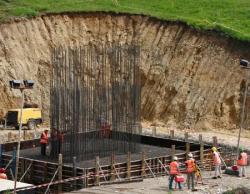
Footings are structural members used to support columns and walls and to transmit and distribute their loads to the soil in such a way that the load bearing capacity of the soil is not exceeded, excessive settlement, differential settlement,or rotation are prevented and adequate safety against overturning or sliding is maintained.
Types of Foundation
- Shallows Foundations
- Deep Foundations
1- Shallows Foundations
Shallow foundations are those founded near to the finished ground surface; generally where the founding depth (Df) is less than the width of the footing and less than 3m. These are not strict rules, but merely guidelines: basically, if surface loading or other surface conditions will affect the bearing capacity of a foundation it is 'shallow'
Shallows foundations are used when surface soils are sufficiently strong and stiff to support the imposed loads; they are generally unsuitable in weak or highly compressible soils, such as poorly-compacted fill, peat, recent lacustrine and alluvial deposits, etc.
Shallow Foundation Types
1. Pad or column footings ( Isolated or Combined )
A-Isolated
used to support single columns. This is one of the most economical types of footings and is used when columns are spaced at relatively long distances
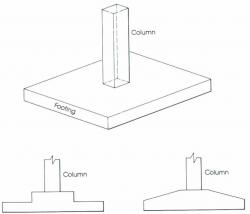
B-Combined
usually support two columns, or three columns not in a row. Combined footings are used when tow columns are so close that single footings cannot be used or when one column is located at or near a property
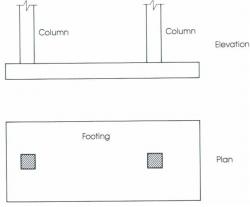
2. Cantilever or strap footings
consist of two single footings connected with a beam or a strap and support two single columns. This type replaces a combined footing and is more economical.
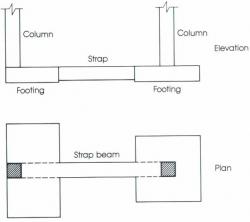
3. Continuous footings
support a row of three or more columns. They have limited width and continue under all columns.
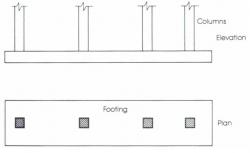
4. Wall Footings
are used to support structural walls that carry loads for other floors or to support nonstructural walls.
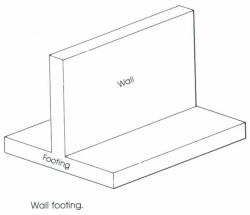
5. Mat (Raft) footings (Thickened slabs)
consists of one footing usually placed under the entire building area. They are used, when soil bearing capacity is low, column loads are heavy single footings cannot be used, piles are not used and differential settlement must be reduced.
Raft foundations are used to spread the load from a structure over a large area, normally the entire area of the structure. They are used when column loads or other structural loads are close together and individual pad foundations would interact.
A raft foundation normally consists of a concrete slab which extends over the entire loaded area. It may be stiffened by ribs or beams incorporated into the foundation.
Raft foundations have the advantage of reducing differential settlements as the concrete slab resists differential movements between loading positions. They are often needed on soft or loose soils with low bearing capacity as they can spread the loads over a larger area.
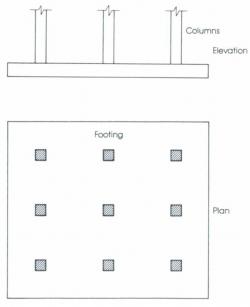
2- Deep Foundations
Deep foundations are those founding too deeply below the finished ground surface for their base bearing capacity to be affected by surface conditions, this is usually at depths >3 m below finished ground level. Deep foundations can be used to transfer the loading to a deeper, more competent strata at depth if unsuitable soils are present near the surface.
Deep foundations are used when there are weak (“bad”) soils near the surface or when loads are very high, such as very large skyscrapers.
Deep foundations derive their support from deeper soils or bedrock
Common Types of Deep Foundations are :
1. Pile foundations
are relatively long, slender members that transmit foundation loads through soil strata of low bearing capacity to deeper soil or rock strata having a high bearing capacity. They are used when for economic, constructional or soil condition considerations it is desirable to transmit loads to strata beyond the practical reach of shallow foundations. In addition to supporting structures, piles are also used to anchor structures against uplift forces and to assist structures in resisting lateral and overturning forces.
are thick slabs used to tie a group of piles together to support and transmit column loads to the piles.
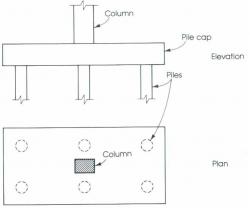
2. Piers
are foundations for carrying a heavy structural load which is constructed insitu in a deep excavation.
3. Caissons
are a form of deep foundation which are constructed above ground level, then sunk to the required level by excavating or dredging material from within the caisson.
4. Compensated foundations
are deep foundations in which the relief of stress due to excavation is approximately balanced by the applied stress due to the foundation. The net stress applied is therefore very small. A compensated foundation normally comprises a deep basement.
References :
Dr. E.W. Sandt
Types of footings - footing types

